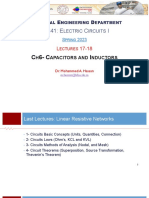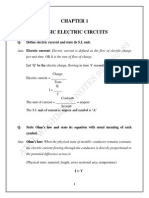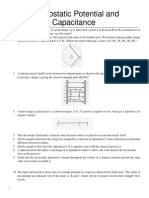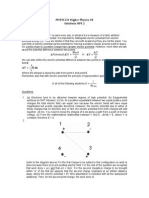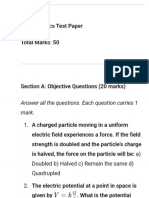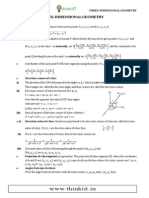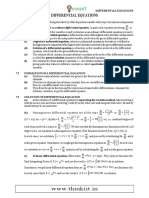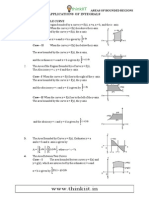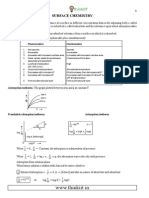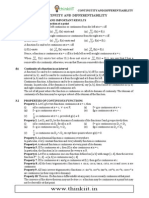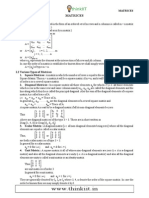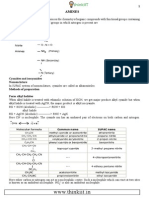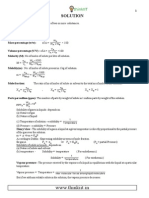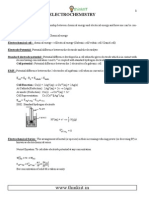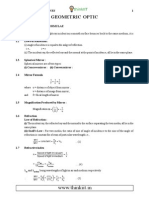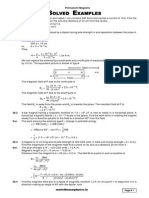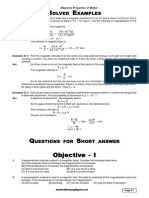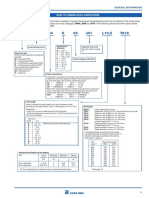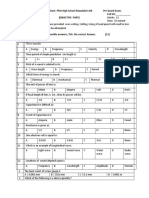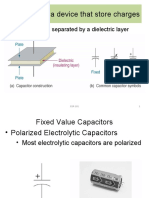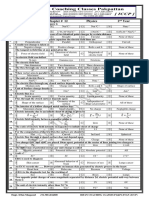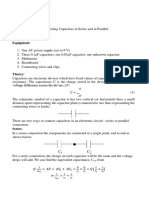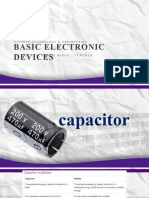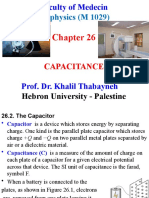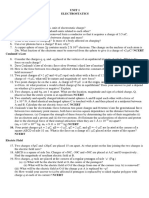Capacitance Theory E
Capacitance Theory E
Uploaded by
thinkiitCopyright:
Capacitance Theory E
Capacitance Theory E
Uploaded by
thinkiitOriginal Description:
Copyright
Share this document
Did you find this document useful?
Is this content inappropriate?
Copyright:
Capacitance Theory E
Capacitance Theory E
Uploaded by
thinkiitCopyright:
PHYSICS
"manishkumarphysics.in"
1
CAPACITANCE
1. INTRODUCTION
A capacitor can store energy in the form of potential energy in an electric field. In this chapter we'll
discuss the capacity of conductors to hold charge and energy.
2. CAPACITANCE OF AN ISOLATED CONDUCTOR
When a conductor is charged its potential increases. It is found that for an isolated conductor (conductor
should be of finite dimension, so that potential of infinity can be assumed to be zero) potential of the
conductor is proportional to charge given to it.
q = charge on conductor
Isolated conductor
q
V = potential of conductor
q V
q = CV
Where C is proportionality constant called capacitance of the conductor.
2.1 Definition of capacitance :
Capacitance of conductor is defined as charge required to increase the potential of conductor
by one unit.
2.2 Important points about the capacitance of an isolated conductor :
(i) It is a scalar quantity.
(ii) Unit of capacitance is farad in SI units and its dimensional formula is M
1
L
2
I
2
T
4
(iii) 1 Farad : 1 Farad is the capacitance of a conductor for which 1 coulomb charge increases
potential by 1 volt.
1 Farad =
Volt 1
Coulomb 1
1 F = 10
6
F, 1nF = 10
9
F or 1 pF = 10
12
F
(iv) Capacitance of an isolated conductor depends on following factors :
(a) Shape and size of the conductor :
On increasing the size, capacitance increases.
(b) On surrounding medium :
With increase in dielectric constant K, capacitance increases.
(c) Presence of other conductors :
When a neutral conductor is placed near a charged conductor, capacitance of conductors
increases.
(v) Capacitance of a conductor do not depend on
(a) Charge on the conductor
(b) Potential of the conductor
(c) Potential energy of the conductor.
3. POTENTIAL ENERGY OR SELF ENERGY OF AN ISOLATED CONDUCTOR
Work done in charging the conductor to the charge on it against its own electric field or total energy
stored in electric field of conductor is called self energy or self potential energy of conductor.
PHYSICS
"manishkumarphysics.in"
2
3.1 Electric potential energy (Self Energy) :
Work done in charging the conductor
W =
dq
C
q
q
0
}
=
C 2
q
2
W = U =
C 2
q
2
=
2
1
CV
2
=
2
qV
.
q = Charge on the conductor
V = Potential of the conductor
C = Capacitance of the conductor.
3.2 Self energy is stored in the electric field of the conductor with energy density (Energy per unit
volume)
dV
dU
=
2
1
e
0
E
2
[The energy density in a medium is
2
1
e
0
e
r
E
2
]
where E is the electric field at that point.
3.3 In case of charged conductor energy stored is only out side the conductor but in case of
charged insulating material it is outside as well as inside the insulator.
4. CAPACITANCE OF AN ISOLATED SPHERICAL CONDUCTOR
The capacitance of an isolated spherical conductor of radius R.
Let there is charge Q on sphere.
Potential V =
R
KQ
Hence by formula : Q = CV
Q =
R
CKQ
C = 4te
0
R
Capacitance of an isolated spherical conductor
C = 4te
0
R
(i) If the medium around the conductor is vacuum or air.
C
Vacuum
= 4te
0
R
R = Radius of spherical conductor. (may be solid or hollow.)
(ii) If the medium around the conductor is a dielectric of constant K from surface of sphere
to infinity.
C
medium
= 4te
0
KR
(iii)
vaccum / air
medium
C
C
= K = dielectric constant.
Example 1. Find out the capacitance of the earth ? (Radius of the earth = 6400 km)
Solution : C = 4te
0
R =
9
3
10 9
10 6400
= 711 F
PHYSICS
"manishkumarphysics.in"
3
5. SHARING OF CHARGES ON JOINING TWO CONDUCTORS (BY A
CONDUCTING WIRE) :
Initially Finally
Q
1
Q
2
C
1
C
2
Q'
1
Q'
2
C
1
C
2
(i) Whenever there is potential difference, there will be movement of charge.
(ii) If released, charge always have tendency to move from high potential energy to low potential
energy.
(iii) If released, positive charge moves from high potential to low potential [if only electric force
act on charge].
(iv) If released, negative charge moves from low potential to high potential [if only electric force
act on charge].
(v) The movement of charge will continue till there is potential difference between the conductors
(finally potential difference = 0).
(vi) Formulae related with redistribution of charges :
Before connecting the conductors
Parameter I
st
Conductor II
nd
Conductor
Capaci tance C
1
C
2
Charge Q
1
Q
2
Potenti al V
1
V
2
After connecti ng the conductors
Parameter I
s t
Conductor I I
nd
Conduct or
Capaci t ance C
1
C
2
Char ge
'
1
Q
'
2
Q
Pot ent i al V V
V =
2
'
2
1
'
1
C
Q
C
Q
=
2
1
'
2
'
1
C
C
Q
Q
=
But,
'
1
Q +
'
2
Q = Q
1
+ Q
2
V =
2 1
2 1
C C
Q Q
+
+
=
2 1
2 2 1 1
C C
V C V C
+
+
PHYSICS
"manishkumarphysics.in"
4
Q
1
' =
2 1
1
C C
C
+
(Q
1
+ Q
2
)
and Q
2
' =
2 1
2
C C
C
+
(Q
1
+Q
2
)
Heat loss during redistribution :
AH =
2
1
2 1
2 1
C C
C C
+
(V
1
V
2
)
2
The loss of energy is in the form of Joule heating in the wire.
Note : Always put Q
1
, Q
2
, V
1
and V
2
with sign.
Example 2. A and B are two isolated conductors (that means they are
placed at a large distance from each other). When they are
joined by a conducting wire:
(i) Find out final charges on A and B ?
(ii) Find out heat produced during the process of flow of charges.
(iii) Find out common potential after joining the conductors by conducting wires?
Solution : (i) Q
A
' =
6 3
3
+
(6 + 3) = 3C
Q
B
' =
6 3
6
+
(6 + 3) = 6C
(ii) AH =
2
1
.
) F 6 F 3 (
F 6 . F 3
+
.
2
2
1
2 |
.
|
\
|
=
2
1
. (2F) .
2
2
3
|
.
|
\
|
=
4
9
J
(iii) V
C
=
F 6 F 3
C 6 C 3
+
+
= 1volt.
6. CAPACITOR :
A capacitor or condenser consists of two conductors separated by an insulator or dielectric.
(i) When uncharged conductor is brought near to a charged conductor, the charge on conductors
remains same but its potential decreases resulting in the increase of capacitance.
(ii) In capacitor two conductors have equal but opposite charges.
(iii) The conductors are called the plates of the capacitor. The name of the capacitor depends on
the shape of the capacitor.
(iv) Formulae related with capacitors
(a) Q = CV
A
B
+Q
A
Q
B
C =
A B
B
B A
A
V V
Q
V V
Q
V
Q
=
Q = Charge of positive plate of capacitor.
V = Potential difference between positive and negative plates of capacitor
C = Capacitance of capacitor.
(b) Energy stored in the capacitor
PHYSICS
"manishkumarphysics.in"
5
A B
Initially charge = 0 0
Intermediate
q q
+
q
C
Finally,
+Q Q
W =
}
dW
=
}
Q
0
dq
C
q
=
C
Q
2
Energy stored in the capacitor = U =
C 2
Q
2
=
2
1
CV
2
=
2
1
QV..
This energy is stored inside the capacitor in its electric field with energy density
dV
dU
=
2
1
eE
2
;k
2
1
e
0
e
r
E
2
.
(v) The capacitor is represented as following:
,
(vi) Based on shape and arrangement of capacitor plates there are various types of capacitors.
(a) Parallel plate capacitor.
(b) Spherical capacitor.
(c) Cylindrical capacitor.
(vii) Capacitance of a capacitor depends on
(a) Area of plates.
(b) Distance between the plates.
(c) Dielectric medium between the plates.
(viii) Electric field intensity between the plates of capacitors (air filled )
E = o/e
0
= V/d
(ix) Force experienced by any plate of capacitor
F = q
2
/2Ae
0
Example 3. Find out the capacitance of parallel plate capacitor of plate areaAand plate separation d.
Solution :
d
A
B
+Q
Q
Plate Area = A
d << size of the plate
E =
0
A
Q
e
V
A
V
B
= E.d. =
0
A
Qd
e
=
C
Q
C =
d
A
0
e
where A = area of the plates.
d = distance between plates.
PHYSICS
"manishkumarphysics.in"
6
7. CIRCUIT SOLUTION FOR RC CIRCUIT AT t = 0 (INITIAL STATE)
AND AT t = (FINAL STATE)
Note : (i) Charge on the capacitor does not change instantaneously or suddenly if there is a resistance in the
path (series) of the capacitor.
(ii) When an uncharged capacitor is connected with battery then its charge is zero initially hence
potential difference across it is zero initially. At this time the capacitor can be treated as a conduct-
ing wire
(iii) The current will become zero finally (that means in steady state) in the branch which contains
capacitor.
Example 4. Find out current in the circuit and charge on capacitor
which is initially uncharged in the following situations.
(a) Just after the switch is closed.
(b) After a long time when switch was closed.
Solution : (a) For just after closing the switch:
potential difference across capacitor = 0
Q
C
= 0 i =
2
10
= 5A
(b) After a long time
at steady state current i = 0
and potential difference across capacitor = 10 V
Q
C
= 3 10 = 30 C
Example 5. Find out current I
1
, I
2
, I
3
, charge on capacitor and
dt
dQ
of
capacitor in the circuit which is initially uncharged in the
following situations.
(a) Just after the switch is closed
(b) After a long time when switch is closed.
Solution : (a) Initially the capacitor is uncharged so its behaviour is like a conductor
R R
R
I
3
c
0 0 0
E
A B C
D
F
x
c
x
I
1 I
2
Let potential at A is zero so at B and C also zero and at F it is c. Let
PHYSICS
"manishkumarphysics.in"
7
potential at E is x so at D also x. Apply Kirchhoffs I
st
law at point E :
R
x c
+
R
0 x
+
R
0 x
= 0
R
x 3
=
R
c
x =
3
c
; Q
c
= 0
I
1
=
R
3 / c + c
=
R 3
2c
I
2
=
dt
dQ
=
R 3
c
and I
3
=
R 3
c
Alternatively
i
1
=
eq
R
c
=
2
R
R +
c
=
R 3
2c
i
2
= i
3
=
2
i
1
=
R 3
c
and
dt
dQ
= i
2
=
R 3
c
(b) at t = (finally)
capacitor completely charged so their will be no current through it.
I
2
= 0, I
1
= I
3
=
R 2
c
V
E
V
B
= V
D
V
C
= (c/2R)R = c/2
Q
C
=
2
C c
,
dt
dQ
= I
2
= 0
I
1
I
2
I
3
Q dQ /dt
Time
t = 0
R 3
2c
R 3
c
R 3
c
0
R 3
c
Finally
t =
R 2
c
0
R 2
c
2
C c
0
Example 6. At t = 0 switch S
1
is closed and remains closed for a long time and S
2
remains open. Now S
1
is
opened and S
2
is closed. Find out
(i) The current through the capacitor immediately after that moment
(ii) Charge on the capacitor long after that moment.
(iii) Total charge flown through the cell of emf 2c after S
2
is closed.
Solution : (i) Let Potential at point A is zero. Then at point B and C it will be c
(because current through the circuit is zero).
V
B
V
A
= (c 0)
Charge on capacitor = C(c 0) = Cc
Now S
2
is closed and S
1
is open. (p.d. across capacitor
and charge on it will not change suddenly)
Potential at A is zero so at D it is 2c.
PHYSICS
"manishkumarphysics.in"
8
current through the capacitor =
R
) 2 ( c c
=
R
3c
(B to D)
(ii) after a long time, i = 0
V
B
V
A
= V
D
V
A
= 2c
Q = C (2c 0) = 2cC
(iii) The charge on the lower plate (which is connected to the battery)
changes from cCto 2cC.
this charge will come form the battery,
charge flown from that cell is 3cCdownward.
Example 7. Acapacitor of capacitance C which is initially uncharged is connected with a battery. Find out heat
dissipated in the circuit during the process of charging.
Solution : Final status
Let potential at point A is 0, so at B also 0 and at C and D it is c. finally, charge on the capacitor
Q
C
= cC
U
i
= 0
U
f
=
2
1
CV
2
=
2
1
Cc
2
work done by battery =
}
Pdt
W =
}
cidt
= c
}
idt
= c . Q = c. cC = c
2
C
(Now onwards remember that w.d. by battery = cQ if Q has flown out of the cell from high potential
and w.d. on battery is cQ if Q has flown into the cell through high potential)
Heat produced = W (U
f
U
i
) = c
2
C
2
1
c
2
C =
2
C
2
c
.
Example 8. Acapacitor of capacitance Cwhich is initially charged upto a potential difference c is connected with
a battery of emf c such that the positive terminal of battery is connected with positive plate of
capacitor. Find out heat loss in the circuit during the process of charging.
Solution :
Since the initial and final charge on the capacitor is same before and after connection.
Here no charge will flow in the circuit so heat loss = 0
PHYSICS
"manishkumarphysics.in"
9
Example 9. Acapacitor of capacitance Cwhich is initially charged upto a potential difference c is connected with
a battery of emf c/2 such that the positive terminal of battery is connected with positive plate of
capacitor. After a long time
(i) Find out total charge flow through the battery
(ii) Find out total work done by battery
(iii) Find out heat dissipated in the circuit during the process of charging.
Solution : (i) Let potential of A is 0 so at B it is
2
c
. So final charge on capacitor = Cc/2
Charge flow through the capacitor = (Cc/2 Cc) = Cc/2
So charge is entering into battery.
(ii) finally,
Change in energy of capacitor = U
final
U
initial
=
2
1
C
2
2
|
.
|
\
| c
2
C
2
c
=
8
1
c
2
C
2
1
c
2
C =
8
C 3
2
c
Work done by battery =
2
c
|
.
|
\
| c
2
C
=
4
C
2
c
(iii) Work done by battery = Change in energy of capacitor + Heat produced
Heat produced =
8
C 3
2
c
4
C
2
c
=
8
C
2
c
8. DISTRIBUTION OF CHARGES ON CONNECTING TWO CHARGED CAPACITORS:
When two capacitors are C
1
and C
2
are connected as shown in figure
Before connecting the capacitors
Parameter I
st
Capacitor II
nd
Capacitor
Capacitance C
1
C
2
Charge Q
1
Q
2
Potenti al V
1
V
2
PHYSICS
"manishkumarphysics.in"
10
After connecting the capacitors
Parameter I
st
Capacitor II
nd
Capacitor
Capacitance C
1
C
2
Charge Q
1
Q
2
Potenti al V V
(a) Common potential :
By charge conservation of plates A and C before and after connection.
Q
1
+ Q
2
= C
1
V + C
2
V
V =
2 1
2 1
C C
Q Q
+
+
=
2 1
2 2 1 1
C C
V C V C
+
+
=
ce tan capaci Total
e arg ch Total
(b) Q
1
' = C
1
V =
2 1
1
C C
C
+
(Q
1
+ Q
2
) Q
2
' = C
2
V =
2 1
2
C C
C
+
(Q
1
+Q
2
)
(c) Heat loss during redistribution :
AH = U
i
U
f
=
2
1
2 1
2 1
C C
C C
+
(V
1
V
2
)
2
The loss of energy is in the form of Joule heating in the wire.
Note : (i) When plates of similar charges are connected with each other (+ with + and with ) then put
all values (Q
1
, Q
2
, V
1
, V
2
) with positive sign.
(ii) When plates of opposite polarity are connected with each other (+ with ) then take charge and
potential of one of the plate to be negative.
Derivation of above formulae :
Let potential of B and D is zero and common potential on capacitors is V, then at A and C it will be V
C
1
V + C
2
V = C
1
V
1
+ C
2
V
2
V =
2 1
2 2 1 1
C C
V C V C
+
+
H =
2
1
C
1
V
1
2
+
2
1
C
2
V
2
2
2
1
(C
1
+ C
2
)V
2
=
2
1
C
1
V
1
2
+
2
1
C
2
V
2
2
2
1
) C C (
) V C V C (
2 1
2
2 2 1 1
+
+
=
2
1
(
(
+
+ + +
2 1
2 1 2 1
2
2
2
2
2
1
2
1
2
2
2
2
2
2 1 2
2
1 2 1
2
1
2
1
C C
V V C C 2 V C V C V C V C C V C C V C
PHYSICS
"manishkumarphysics.in"
11
=
2
1
2 1
2 1
C C
C C
+
(V
1
V
2
)
2
H =
2
1
2 1
2 1
C C
C C
+
(V
1
V
2
)
2
when oppositely charge terminals are connected then
C
1
V + C
2
V = C
1
V
1
C
2
V
2
V =
2 1
2 2 1 1
C C
V C V C
+
and H =
2
1
2 1
2 1
C C
C C
+
(V
1
+ V
2
)
2
Example 10 Find out the following if Ais connected with C and B is connected with D.
(i) How much charge flows in the circuit.
(ii) How much heat is produced in the circuit.
Solution : (i)
A B
+
D C
+
Q = 3V
2
Q = 2V
1
V 0
Let potential of B and D is zero and common potential on capacitors is V, then at Aand C it will be V.
By charge conservation,
3V + 2V = 40 + 30
5V = 70
V = 14 volt
Chargeflow
= 40 28
= 12 C
Now final charges on each plate is shown in the figure
A
B
+
D
C
28 C 28 C
+12 C +12 C
42 C 42 C
+
(ii) Heat produced =
2
1
2 (20)
2
+
2
1
3 (10)
2
2
1
5 (14)
2
= 400 + 150 490
= 550 490
= 60 J
Note : (i) When capacitor plates are joined then the charge remains conserved.
(ii) We can also use direct formula of redistribution as given above.
PHYSICS
"manishkumarphysics.in"
12
Example 11. Repeat above question if Ais connected with D and B is connected with C.
Q = 2V
1
Q = 3V
2
B
C
A
D
V
0
Solution : Let potential of B and C is zero and common potential on capacitors is V, then at Aand D it will be V
2V + 3V = 10
V = 2 volt
Now charge on each plate is shown in the figure
6 C 6 C
4 C 4 C
36 C
36 C
B
C
A
D
Heat produced = 400 + 150
2
1
5 4
= 550 10
= 540 J
Note : Here heat produced is more. Think why?
Example 12. Three capacitors as shown of capacitance 1F, 2F and 2F are charged upto potential difference
30 V, 10 V and 15 V respectively. If terminal Ais connected with D, C is connected with E and F is
connected with B. Then find out charge flow in the circuit and find the final charges on capacitors.
Solution : Let charge flow is q.
Nowapplying kirchhoff's voltage low
2
) 20 q (
2
) q 30 ( +
+
1
q 30
= 0
q
1 F 2 F
20q
D
C
E F B A
q30
30q
30+q
q30
+
+
20+q
2 F
2q = 25
q = 12.5 C
Final charges on plates
+
+
+
42.5 C +42.5 C
7.5 C +7.5 C
+17.5 C 17.5 C
12.5 C
PHYSICS
"manishkumarphysics.in"
13
Example 13. In the given circuit find out the charge on each capacitor. (Initially they are uncharged)
F
E
D
C B A
0
10 V
10 V
+ +
+
x
30 V
30 V
25 V
25 V G
Let potential at A is 0, so at D it is 30 V, at F it is 10 V and at point G potential is 25V and let
potential at E is x. Now apply kirchhoffs I
st
law at point E. ( total charge of all the plates connected
to 'E' must be same as before i.e. 0)
(x 10) + (x 30)2 + (x + 25)2 = 0
5x = 20
x = 4 V
Final charges :
Q
2F
= (30 4)2 = 52 C
Q
1F
= (10 4) = 6C
Q
2F
= (4 (25))2 = 58 C
9. COMBINATION OF CAPACITORS :
9.1 Series Combination :
(i) When initially uncharged capacitors are connected as
shown t hen t he combi nat i on i s cal l ed ser i es
combination.
(ii) All capacitors will have same charge but different potential difference across them.
(iii) We can say that
V
1
=
1
C
Q
V
1
= potential across C
1
Q = charge on positive plate of C
1
C
1
= capacitance of capacitor similarly
V
2
=
2
C
Q
, V
3
=
3
C
Q
; ........
(iv) V
1
: V
2
: V
3
=
1
C
1
:
2
C
1
:
3
C
1
We can say that potential difference across capacitor is inversely proportional to its capacitance
in series combination.
V
C
1
PHYSICS
"manishkumarphysics.in"
14
Note : In series combination the smallest capacitor gets maximum potential.
(v)
V
......
C
1
C
1
C
1
C
1
V
3 2 1
1
1
+ + +
=
V
......
C
1
C
1
C
1
C
1
V
3 2 1
2
2
+ + +
=
V
......
C
1
C
1
C
1
C
1
V
3 2 1
3
3
+ + +
=
Where V = V
1
+ V
2
+ V
3
(vi) Equivalent Capacitance :
Equivalent capacitance of any combination is that capacitance which when connected
in place of the combination, stores same charge and energy that of the combination.
In series :
eq
C
1
=
1
C
1
+
2
C
1
+
3
C
1
+ .......
Note : In series combination equivalent capacitance is always less the smallest capacitor of combination.
(vii) Energy stored in the combination
U
combination
=
1
2
C 2
Q
+
2
2
C 2
Q
+
3
2
C 2
Q
U
combination
=
eq
2
C 2
Q
Energy supplied by the battery in charging the combination
U
battery
= Q V = Q .
eq
C
Q
=
eq
2
C
Q
battery
n combinatio
U
U
=
2
1
Note : Half of the energy supplied by the battery is stored in form of electrostatic energy and half of the energy
is converted into heat through resistance. (if capacitors are initially uncharged)
PHYSICS
"manishkumarphysics.in"
15
Derivation of Formulae :
meaning of equivalent capacitor
C
eq
=
V
Q
Now,
Initially, the capacitor has no charge.
Applying kirchhoffs voltage law
1
C
Q
+
2
C
Q
+
3
C
Q
+ V = 0.
V = Q
(
+ +
3 2 1
C
1
C
1
C
1
Q
V
=
3 2 1
C
1
C
1
C
1
+ +
eq
C
1
=
3 2 1
C
1
C
1
C
1
+ +
in general
eq
C
1
=
=
n
1 n
n
C
1
Example 14. Three initially uncharged capacitors are connected in series as shown in circuit with a battery of emf
30V. Find out following:-
(i) charge flowthrough the battery,
(ii) potential energy in 3 F capacitor.
(iii) U
total
in capacitors
(iv) heat produced in the circuit
Solution :
eq
C
1
=
2
1
+
3
1
+
6
1
=
6
1 2 3 + +
= 1
C
eq
= 1F.
(i) Q = C
eq
V = 30C.
(ii) charge on 3F capacitor = 30C
energy =
C 2
Q
2
=
3 2
30 30
= 150J
(iii) U
total
=
2
30 30
J = 450 J
(iv) Heat produced = (30 C) (30) 450 J = 450 J.
PHYSICS
"manishkumarphysics.in"
16
Example 15. Two capacitors of capacitance 1 F and 2F are charged to potential difference 20V and 15V as
shown in figure. If now terminal B and C are connected together terminal Awith positive of battery
and D with negative terminal of battery then find out final charges on both the capacitor
Solution : Nowapplying kirchoff voltage law
1
) q 20 ( +
2
q 30 +
+ 30 = 0
40 2q 30 q = 60
3q = 10
Charge flow= 10/3 C.
Charge on capacitor of capacitance 1F = 20 + q =
3
50
C
Charge on capacitor of capacitance 2F = 30 + q =
3
80
C
9.2 Parallel Combination :
(i) When one plate of each capacitors (more than one) is
connected together and the other plate of each
capacitor is connected together, such combination is
called parallel combination.
(ii) All capacitors have same potential difference but different charges.
(iii) We can say that :
Q
1
= C
1
V
Q
1
= Charge on capacitor C
1
C
1
= Capacitance of capacitor C
1
V = Potential across capacitor C
1
(iv) Q
1
: Q
2
: Q
3
= C
1
: C
2
: C
3
The charge on the capacitor is proportional to its capacitance
Q C
(v) Q
1
=
3 2 1
1
C C C
C
+ +
Q Q
2
=
3 2 1
2
C C C
C
+ +
Q
Q
3
=
3 2 1
3
C C C
C
+ +
Q
Where Q = Q
1
+ Q
2
+ Q
3
......
Note : Maximum charge will flow through the capacitor of largest value.
(vi) Equivalent capacitance of parallel combination
C
eq
= C
1
+ C
2
+ C
3
Note : Equivalent capacitance is always greater than the largest capacitor of combination.
PHYSICS
"manishkumarphysics.in"
17
(vii) Energy stored in the combination :
V
combination
=
2
1
C
1
V
2
+
2
1
C
2
V
2
+ .... =
2
1
(C
1
+ C
2
+ C
3
.....) V
2
=
2
1
C
eq
V
2
U
battery
= QV = CV
2
battery
n combinatio
U
U
=
2
1
Note : Half of the energy supplied by the battery is stored in form of electrostatic energy and half of the energy
is converted into heat through resistance. (if all capacitors are initially uncharged)
Formulae Derivation for parallel combination :
Q = Q
1
+ Q
2
+ Q
3
= C
1
V + C
2
V + C
3
V
= V(C
1
+ C
2
+ C
3
)
C
1
Q
1
C
2
Q
2
Q
C
3
Q
3
V
Q
V
0
0
V
V
Q
= C
1
+ C
2
+ C
3
C
eq
= C
1
+ C
2
+ C
3
Ingeneral
=
=
n
1 n
n eq
C C
Example 16. Three initially uncharged capacitors are connected to a battery of 10 V is parallel combination find
out following
(i) charge flowfrom the battery
(ii) total energy stored in the capacitors
(iii) heat produced in the circuit
(iv) potential energy in the 3F capacitor.
Solution : (i) Q = (30 + 20 + 10)C = 60 C
(ii) U
total
=
2
1
6 10 10 = 300 J
(iii) heat produced = 60 10 300 = 300 J
(iv) U
3F
=
2
1
3 10 10 = 150 J
9.3 Mixed Combination :
The combination which contains mixing of series parallel combinations or other complex
combinations fall in mixed category.
There are two types of mixed combinations
(i) Simple (ii) Complex.
PHYSICS
"manishkumarphysics.in"
18
Example 17. In the given circuit find out charge on 6F and 1F capacitor.
Solution : It can be simplified as
C
eq
=
9
18
= 2F
charge flow through the cell = 30 2 C
Q = 60 C
Nowcharge on 3F = Charge on 6F= 60 C
Potential difference across 3F = 60/ 3= 20 V
Charge on 1F = 20 C.
10. CHARGING AND DISCHARGING OF A CAPACITOR
10.1 Charging of a condenser :
(i) In the following circuit. If key 1 is closed then the condenser gets
charged. Finite time is taken in the charging process. The quan-
tity of charge at any instant of time t is given by q = q
0
[1 e
(t/RC)
]
Where q
0
= maximum final value of charge at t = .
According to this equations the quantity of charge on the
condenser increases exponentially with increase of time.
(ii) If t = RC = t then
q = q
0
[1 e
(RC/RC)
] = q
0 (
e
1
1
or q = q
0
(1 0.37) = 0.63 q
0
= 63% of q
0
(iii) Time t = RC is known as time constant.
i.e. the time constant is that time during which the charge rises on the condenser plates to 63% of
its maximum value.
(iv) The potential difference across the condenser plates at any instant of time is given by
V = V
0
[1 e
(t/RC)
] volt
(v) The potential curve is also similar to that of charge. During charging process an electric current flows
in the circuit for a small interval of time which is known as the transient current. The value of this
current at any instant of time is given by
I = I
0
[e
(t/RC)
] ampere
According to this equation the current falls in the circuit exponentially (Fig.).
PHYSICS
"manishkumarphysics.in"
19
(vi) If t = RC = t = Time constant
I = I
0
e
(RC/RC)
=
e
0
I
= 0.37 I
0
= 37% of I
0
i.e. time constant is that time during which current in
the circuit falls to 37% of its maximum value.
Derivation of formulae for charging of capacitor
it is given that initially capacitor is uncharged.
let at any time charge on capacitor is q
Applying kirchoff voltage law
c iR
C
q
= 0 iR =
C
q C c
i =
CR
q C c
dt
dq
=
CR
q C c
dt
dq
=
CR
q C c
q C
CR
c
. dq = dt.
}
c
q
O
q C
dq
=
}
t
O
RC
dt
ln (cC q) + ln cC =
RC
t
ln
q C
C
c
c
=
RC
t
cC q = cC . e
t/RC
q = cC(1 e
t/RC
)
t=RC
t
q
cC
0.63 C c
O
RC = time constant of the RC series circuit.
After one time constant
q = cC
|
.
|
\
|
e
1
1
= cC (1 0.37) = 0.63 cC.
Current at any time t
i =
dt
dq
= cC
|
|
.
|
\
|
|
.
|
\
|
RC
1
e
RC / t
=
RC / t
e
R
c
PHYSICS
"manishkumarphysics.in"
20
Voltage across capacitor after one time constant V = 0.63 c
Q = CV
V
C
= c(1 e
t/RC
)
t=RC
t
c
0.63c
O
V
C
Voltage across the resistor
V
R
= iR
= ce
t/RC
By energy conservation,
Heat dissipated = work done by battery AUcapacitor
= Cc(c) (
2
1
Cc
2
0)
=
2
1
Cc
2
Alternatively :
Heat = H =
}
0
2
Rdt i
=
}
c
0
2
2
R
RC
t 2
e
R dt
=
R
2
c
}
0
RC / t 2
e
dt
=
R
2
c
(
(
(
0
RC
t 2
RC / 2
e
=
R 2
RC
2
c
(
(
0
RC
t 2
e
=
2
C
2
c
Note:-
c
0.63
1
2
c
V
C
t
In the figure time constant of (2) is more than (1)
PHYSICS
"manishkumarphysics.in"
21
Example 18 Without using the formula of equivalent. Find out charge on capacitor and current in all the branches
as a function of time.
Solution : Applying KVL in ABDEA
c iR =
C 2
q
i =
CR 2
q
R
c
=
CR 2
q C 2 c
q C 2
dq
c
=
CR 2
dt
q C 2
dq
c
=
CR 2
dt
}
c
q
0 ) q C 2 (
dq
=
CR 2
t
C 2
q C 2
c
c
= e
t/2RC
q = 2cC (1 e
t/2RC
)
q
1
=
2
q
= cC (1 e
t/2RC
) i
1
=
R 2
c
e
t/2RC
q
2
=
2
q
= cC (1 e
t/2RC
) i
2
=
R 2
c
e
t/2RC
Alternate solution
by equivalent
Time constant of circuit = 2C R = 2RC
maximum charge on capacitor = 2C c = 2Cc
Hence equations of charge and current are as given below
q = 2cC (1 e
t/2RC
)
q
1
=
2
q
= cC (1 e
t/2RC
) i
1
=
R 2
c
e
t/2RC
q
2
=
2
q
= cC (1 e
t/2RC
) i
2
=
R 2
c
e
t/2RC
PHYSICS
"manishkumarphysics.in"
22
Example 19 Acapacitor is connected to a 36 V battery through a resistance of 20O. It is found that the potential
difference across the capacitor rises to 12.0 V in 2s. Find the capacitance of the capacitor.
Solution : The charge on the capacitor during charging is given by Q = Q
0
(1 e
t/RC
).
Hence, the potential difference across the capacitor is V = Q/C = Q
0
/C (1 e
t/RC
).
Here, at t = 2 s, the potential difference is 12V whereas the steady potential difference is
Q
0
/C = 36V. So, 12V = 36V(1 e
t/RC
)
or, 1 e
t/RC
=
3
1
or, e
t/RC
=
3
2
or,
|
.
|
\
|
=
2
3
n
RC
t
= 0.405 or, RC =
405 . 0
t
=
45 . 0
s 2
= 4.936 s
or, C =
O
20
s 936 . 4
= 0.25 F..
Example 20. Initially the capacitor is uncharged find the charge on capacitor
as a function of time, if switch is closed at t = 0.
Solution : Applying KVL in loop ABCDA
c iR (i i
1
) R = 0 R
R
ii
1
i
1
i
q
q
+
q/C
A
B C
D
E
F
R
c 2iR + i
1
R = 0 ...(i)
Applying KVL in loop ABCEFDA
c iR i
1
R
C
q
= 0
by eq (i)
2
R i 2 R i 2
1 1
c c
=
C
q
cC 3i
1
RC = 2q
cC 2q = 3
dt
dq
. RC
}
c
q
0
q 2 C
dq
=
}
t
0
RC 3
dt
2
1
ln
C
q 2 C
c
c
=
RC 3
t
q =
2
C c
( )
RC 3 / t 2
e 1
Method for objective :
In any circuit when there is only one capacitor then
q = Q
st
( )
t
/ t
e 1 ; Q
st
= steady state charge on capacitor (has been found in article 6 in this sheet)
t = R
eff
. C
R
effective
is the resistance between the capacitor when battery is replaced by its internal resistance.
10.2 Discharging of a condenser :
(i) In the above circuit (in article 10.1) if key 1 is opened
and key 2 is closed then the condenser gets discharged.
PHYSICS
"manishkumarphysics.in"
23
(ii) The quantity of charge on the condenser at any instant
of time t is given by q = q
0
e
(t/RC)
i.e. the charge falls exponentially.
here q
0
= initial charge of capacitor
(iii) If t = RC= t = time constant, then
q =
e
q
0
= 0.37q
0
= 37% of q
0
i.e. the time constant is that time during which the charge on condenser plates in discharge pro-
cess, falls to 37%
(iv) The dimensions of RC are those of time i.e. MLT
1
and the dimensions of
RC
1
are those of fre-
quency i.e. M
0
L
0
T
1
.
(v) The potential difference across the condenser plates at any instant of time t is given by
V = V
0
e
(t/RC)
Volt.
(vi) The transient current at any instant of time is given by I = I
0
e
(t/RC)
ampere.
i.e. the current in the circuit decreases exponentially but its direction is opposite to that of charging
current. ( ive only means that direction of current is opposite to that at charging current)
Derivation of equation of discharging circuit :
Applying K.V.L.
0 iR
C
q
= +
i =
CR
q
}
q
Q
q
dq
=
}
t
0
CR
dt
ln
Q
q
= +
RC
t
q = Q .
RC / t
e
i =
RC / t
e
RC
Q
dt
dq
=
= i
0
e
t/RC
PHYSICS
"manishkumarphysics.in"
24
Example 21 At t = 0, switch is closed, if initially C
1
is uncharged and
C
2
is charged to a potential difference 2c then find out
following
(Given C
1
= C
2
= C)
(a) Charge on C
1
and C
2
as a function of time.
(b) Find out current in the circuit as a function of time.
(c) Also plot the graphs for the relations derived in part (a).
Solution : Let q charge flow in time 't' from the battery as shown.
The charge on various plates of the capacitor is as shown in the figure.
Nowapplying KVL
c
C
q
iR
C
C 2 q c
= 0
c
C
q
C
q
+ 2c iR = 0
3c =
C
q 2
+ iR 3c iR =
C
q 2
3cC iRC = 2q
dt
dq
RC = 3cC 2q
}
c
q
0 q 2 C 3
dq
=
}
t
0 RC
dt
RC
t
C 3
q 2 C 3
n
2
1
= |
.
|
\
|
c
c
|
.
|
\
|
c
c
C 3
q 2 C 3
ln
=
RC
t 2
3cC 2q = 3cC
RC / t 2
e
3cC (1 e
2t/RC
) = 2q q = C
2
3
c (1 e
2t/RC
)
(charge on C, as function of time) Ans.
i =
dt
dq
=
R
3c
e
2t/RC
Ans.
Charge on C
2
as function of time :
q = 2cC q
= 2cC
2
3
cC +
2
3
cC e
2t/RC
=
2
C c
+
2
3
cCe
2t/RC
=
2
C c
| |
RC / t 2
e 3 1
+
PHYSICS
"manishkumarphysics.in"
25
Example 22 Two parallel conducting plates of a capacitor of capacitance C containing charges Q and 2Q at a
distance d apart. Find out potential difference between the plates of capacitors.
Solution : Capacitance = C
Electric field =
0
A 2
Q 3
e
V =
0
A 2
Qd 3
e
V =
C 2
Q 3
11. CAPACITORS WITH DIELECTRIC
(i) In absence of dielectric
E =
0
e
o
(ii) When a dielectric fills the space between the plates then molecules having dipole moment align
themselves in the direction of electric field.
o
b
= induced charge density (called bound charge because it is not due to free electrons).
- For polar molecules dipole moment = 0
- For non-polar molecules dipole moment = 0
(iii) Capacitance in the presence of dielectric
C =
V
A o
=
d .
K
A
0
e
o
o
=
d
AK
0
e
=
d
AK
0
e
Here capacitance is increased by a factor K.
C =
d
AK
0
e
(iv) Polarisation of material :
When nonpolar substance is placed in electric field then dipole moment is induced in the molecule.
PHYSICS
"manishkumarphysics.in"
26
This induction of dipole moment is called polarisation of material. The induced charge also produce
electric field.
o
o
+ + + + + + + + + + + + + + +
o
b
+o
b
E
E
ind
o
b
= induced (bound) charge density.
E
in
= E E
ind
=
0
b
0
e
o
e
o
It is seen the ratio of electric field between the plates in absence of dielectric and in presence of
dielectric is constant for a material of dielectric. This ratio is called 'Dielectric constant' of that
material. It is represented by c
r
or k.
E
in
=
0
Ke
o
o
b
= o |
.
|
\
|
K
1
1
(v) If the medium does not filled between the plates completely then electric field will be as shown in
figure
Case : (1)
The total electric field produced by bound induced charge on the dielectric outside the slab is zero because
they cancel each other.
Case : (2)
(vi) Comparison of E(electric field), o (surface charges density), Q(charge ), C(capacitance) and before
and after inserting a dielectric slab between the plates of a parallel plate capacitor.
E
Q
Q
o
- o
d
V
Case I
C =
d
A
0
e
C' =
d
K A
0
e
Q = CV Q' = C'V
PHYSICS
"manishkumarphysics.in"
27
E =
0
e
o
=
0
A
CV
e
E' =
0
Ke
o
=
0
A
CV
e
=
d
V
E =
d
V
Here potential difference between the plates, Here potential difference between the plates
Ed = V Ed = V
E =
d
V
E =
d
V
d
V
=
0
e
o
d
V
=
0
K
'
e
o
Equating both
0 0
K
'
e
o
=
e
o
o' = Ko
In the presence of dielectric, i.e. in case II capacitance of capacitor is more.
(vii) Energy density in a dielectric =
2
r 0
E
2
1
e e
Example 23. If a dielectric slab of thickness t and area A is inserted in between the plates of a parallel plate
capacitor of plate area A and distance between the plates d (d > t) then find out capacitance of
system. What do you predict about the dependence of capacitance on location of slab?
Solution :
C =
v
Q
=
v
A o
V =
0
1
t
e
o
+
0
K
t
e
o
+
0
2
t
e
o
( t
1
+ t
2
= d t)
=
0
e
o
(
+ +
k
t
t t
2 1 V =
0
e
o
(
+
k
t
t d =
C
Q
=
C
A o
C =
K / t t d
A
0
+
e
Note (i) Capacitance does not depend upon the position of dielectric (it can be shifted up or down still
capacitance does not change).
(ii) If the slab is of metal then : C =
t d
A
0
e
(for metal k )
PHYSICS
"manishkumarphysics.in"
28
Example 24 Find out capacitance between A and B if two dielectric slabs of
dielectric constant K
1
and K
2
of thickness d
1
and d
2
and each of
area Aare inserted between the plates of parallel plate capacitor
of plate areaAas shown in figure.
Solution : C =
V
A o
; V = E
1
d
1
+ E
2
d
2
=
0 1
1
K
d
e
o
+
0 2
2
K
d
e
o
=
|
|
.
|
\
|
+
e
o
2
2
1
1
0
k
d
k
d
C =
2
2
1
1
0
K
d
K
d
A
+
e
0 2
2
0 1
1
AK
d
AK
d
C
1
e
+
e
=
This formula suggests that the system between Aand B can be considered as series combination
of two capacitors.
Example 25. Find out capacitance betweenAand B if two dielectric slabs of dielectric constant K
1
and K
2
of area
A
1
andA
2
and each of thickness d are inserted between the plates of parallel plate capacitor of plate
area A as shown in figure. (A
1
+ A
2
= A)
Solution :
C
1
=
d
K A
0 1 1
e
, C
2
=
d
K A
0 2 2
e
E
1
=
d
V
=
0 1
1
K e
o
, E
2
=
d
V
=
0 2
2
K e
o
o
1
=
d
V K
0 1
e
o
2
=
d
V K
0 2
e
C =
V
Q Q
2 1
+
=
V
A A
2 2 1 1
o + o
=
d
A K
d
A K
2 0 2 1 0 1
e
+
e
The combination is equivalent to : C = C
1
+ C
2
Example 26. Find out capacitance between Aand B if three dielectric slabs of
dielectric constant K
1
of areaA
1
and thickness d, K
2
of areaA
2
and
thickness d
1
and K
3
of area A
2
and thickness d
2
are inserted be-
tween theplates of parallel platecapacitor of plateareaAas shown
in figure. (Given distance between the two plates d =d
1
+d
2
)
PHYSICS
"manishkumarphysics.in"
29
Solution : It is equivalent to
C = C
1
+
3 2
3 2
C C
C C
+
C =
2 1
0 2 1
d d
K A
+
e
+
2
0 3 2
1
0 2 2
1
0 3 2
1
0 2 2
d
K A
d
K A
d
K A
.
d
K A
e
+
e
e e
= =
2 1
0 1 1
d d
K A
+
e
+
1 0 3 2 2 0 2 2
0 3 2
2
2
d K A d K A
K K A
e + e
e
=
2 1
0 2 1
d d
K A
+
e
+
1 3 2 2
0 3 2
2
2
d K d K
K K A
+
e
Example 27. A dielectric of constant K is slipped between the plates of parallel
plate condenser in half of the space as shown in the figure. If the
capacity of air condenser is C, then new capacitance between A
and B will be-
(A)
2
C
(B)
K 2
C
(C)
2
C
[1 + K] (D)
C
] K 1 [ 2 +
Solution : This system is equivalent to two capacitors in parallel with area of each plate
2
A
.
C = C
1
+ C
2
=
d
K ) 2 / A (
d
2 / A
0 0
e
+
e
=
d 2
A
0
e
[1 + K] =
2
C
[1 + K]
Hence the correct answer will be (C).
(viii) Force on a dielectric due to charged capacitor :-
(a) If dielectric is completely inside the capacitor
then force is equal to zero.
(b) If dielectric is not completely inside the capacitor.
Case I - Voltage source remains connected
V = constant.
U =
2
1
CV
2
F =
|
.
|
\
|
dx
dU
=
2
V
2
dx
dC
PHYSICS
"manishkumarphysics.in"
30
where C =
d
K xb
0
e
+
d
b ) x (
0
e
C =
d
b
0
e
[Kx + x]
dx
dC
=
d
b
0
e
(K 1)
F =
d 2
V ) 1 K ( b
2
0
e
= constant (does not depend on x)
Case II : When charge on capacitor is constant
C =
d
K xb
0
e
+
d
b ) x (
0
e
, U =
C 2
Q
2
F =
|
.
|
\
|
dx
dU
=
2
2
C 2
Q
.
dx
dC
[where,
dx
dC
=
d
b
0
e
(K 1)]
=
dx
dC
.
C 2
Q
2
2
(here force 'F' depends on x)
Example 28. Find V and E at : ( Q is a point charge kept at the centre of the
nonconducting neutral thick sphere of inner radius 'a' and outer
radius 'b') (dielectric constant = e
r
)
(i) 0 < r < a
(ii) a s r < b
(iii) r > b
Solution : q and +q charge will induce on inner and outer surface respectively
E(0 < r < a) =
2
r
KQ
E (r > b) =
2
r
KQ
E (a s r < b) =
2
r
KQ
2
r
Kq
= 2
r
r
KQ
e
Ans.
q = Q
|
|
.
|
\
|
e
r
1
1
.
V (r > b) =
r
KQ
(a s r s b) V
A
= V
P
+
}
e
r
b
2
r
) dr (
r
KQ
=
|
.
|
\
|
e
+
b
1
r
1 kQ
b
kQ
r
V (r s a)V
B
= V
C
+
}
r
a
2
) dr (
r
KQ
=
b
kQ
+
r
kQ
e
|
.
|
\
|
b
1
a
1
+ kQ
|
.
|
\
|
a
1
r
1
PHYSICS
"manishkumarphysics.in"
31
Example 29. What is potential at a distance r (<R) in a dielectric sphere of uniform
charge density , radius R and dielectric constant c
r
..
Solution : V
A
= V
B
+
q
W
A B
V =
R 4
Q
0
e t
+
}
e e
r
R
r 0
) dr (
3
r
=
R 4
Q
0
e t
+
r 0
2 2
3
) r R (
e e
V
outiside
=
r
KQ
12. COMBINATION OF PARALLEL PLATES
Example 30. Find out equivalent capacitance betweenAand B. (take each plateArea =Aand distance between
two conjugative plates is d)
Solution : Let numbers on the plates The charges will be as shown in the figure.
V
12
= V
32
= V
34
so all the capacitors are in parallel combination.
C
eq
= C
1
+ C
2
+ C
3
=
d
A 3
0
e
Example 31. Find out equivalent capacitance between Aand B. (take each plate Area =A)
Solution :
These are only two capacitors.
C
eq
= C
1
+ C
2
=
d
A 2
0
e
PHYSICS
"manishkumarphysics.in"
32
Example 32. Find out equivalent capacitance between Aand B. (take each plate Area =A)
Solution :
The modified circuit is
C
eq
=
3
C 2
=
d 3
A 2
0
e
Other method : Let charge density as shown
C
eq
=
V
Q
=
V
xA 2
V = V
2
V
4
= (V
2
V
3
) + (V
3
V
4
)
=
0
xd
e
+
0
xd 2
e
=
0
xd 3
e
C
eq
=
xd 3
Ax 2
0
e
=
d 3
A 2
0
e
=
3
C 2
.
Example 33. Find out equivalent capacitance betweenAand B.
A
+
+
+
+
C
B
+
d
d
d
d
Area A
Solution : Let C =
d
A
0
e
Equivalent circuit : -
C 3
5
C 3
2
C
1
C
1
eq
= + =
C
eq
=
5
C 3
=
d 5
A 3
0
e
PHYSICS
"manishkumarphysics.in"
33
Alternative Method : Let charge distribustion on plates as shown :
C =
V
Q
=
AB
V
y x +
Potential of 1 and 4 is same
0
A
y
e
=
0
A
x 2
e
y = 2x
V =
|
|
.
|
\
|
c
+
0
A
x y 2
d C =
d ) x 5 (
A ) x 2 x (
0
e +
=
d 5
A 3
0
e
.
Example 34. Five similar condenser plates, each of areaA, are placed at
equal distance dapart andare connected to asource of e.m.f.
Vas showninthe following diagram. The chargeon the plates
1 and 4 will be-
(A)
d
A
0
e
,
d
A 2
0
e
(B)
d
AV
0
e
,
d
AV 2
0
e
(C)
d
AV
0
e
,
d
AV 3
0
e
(D)
d
AV
0
e
,
d
AV 4
0
e
Solution : by equivalent circuit diagram Charge on first plate
Q = CV
Q =
d
AV
0
e
Charge on fourth plate
Q = C(V) Q =
d
AV
0
e
As plate 4 is repeated twice, hence charge on 4 will be Q = 2Q
Q" =
d
AV 2
0
e
Hence the correct answer will be (B).
13. OTHER TYPES OF CAPACITORS
Spherical capacitor :
This arrangement is known as spherical capacitor.
V
1
V
2
=
(
b
KQ
a
KQ
b
KQ
b
KQ
=
a
KQ
b
KQ
C =
2 1
V V
Q
=
b
KQ
a
KQ
Q
=
) a b ( K
ac
=
a b
ab 4
0
e t
PHYSICS
"manishkumarphysics.in"
34
C =
a b
ab 4
0
e t
If b >> a then
C = 4te
0
a (Like isolated spherical capacitor)
If dielectric mediums are filled as shown then :
C =
a b
ab 4
2
r 0
e e t
Cylindrical capacitor
There are two co-axial conducting cylindrical surfaces
where >> a and >> b
where a and b is radius of cylinders.
Capacitance per unit length C =
V
=
a
b
n K 2
=
a
b
n 2
4
0
e t
=
a
b
n
2
0
e t
Capacitance per unit length =
a
b
n
2
0
e t
F/m
Problem 1. When two isolated conductors Aand B are connected by a conducting wire positive charge will flow
from.
(A) A to B (B) B to A (C) will not flow (D) can not say.
Solution : Charge always flows from higher potential body to lower potential body
Hence, V
A
=
10
30
= 3V V
B
=
5
20
= 4 V
As V
B
> V
A
(B) is correct Answer.
Problem 2. A conductor of capacitance 10F connected to other conductor of capacitance 40 F having
equal charges 100 C initially. Find out final voltage and heat loss during the process?
Answer : (i) V = 4V (ii) H = 225 J.
Solution :
C
1
= 10F C
2
= 40F
PHYSICS
"manishkumarphysics.in"
35
Q
1
= 100 C Q
2
= 100C
V
1
= Q
1
/C
1
= 10 V V
2
= Q
2
/C
2
= 2.5
Final voltage (V) =
) C C (
V C V C
2 1
2 2 1 1
+
+
=
2 1
2 1
C C
Q Q
+
+
=
F 50
C 200
= 4V
Heat loss during the process =
| |
2
2 2
2
1 1
V C V C
2
1
+ ) C C ( V
2
1
2 1
2
+
=
| |
2 2 1 1
V Q V Q
2
1
+
2
1
V
2
(C
1
+ C
2
)
= ] 5 . 12 [ 100
2
1
2
1
16 (50) = 225 J
Problem 3. A capacitor of capacitance C is charged from battery of e.m.f. c and then disconnected. Now the
positive terminal of the battery is connected with negative plate of capacitor. Find out heat loss in the
circuit during the process of charging.
c
B D
+cC C c
Initially
c
B D
+cC C c
finally
Net charge flowthrough battery = 2cC
Work done by battery = c 2cC = 2c
2
C
Heat produced = 2c
2
C. Ans.
Solution : Fromfigure
Net charge flowthrough
battery = Q
final
Q
initial
= cC (cC) = 2cC
workdone by battery (W) = Q V = 2cC c = 2c
2
C
or Heat produced = 2c
2
C
You might also like
- CapacitanceDocument27 pagesCapacitancevenumadhavkattagoni100% (3)
- Ch24 SSMDocument14 pagesCh24 SSMShaodong HuangNo ratings yet
- CapacitorDocument55 pagesCapacitorrahulNo ratings yet
- Note 4 PDFDocument20 pagesNote 4 PDFmarvellous muchechesiNo ratings yet
- Capacitance Type 1Document11 pagesCapacitance Type 1SubhashChandraMishraNo ratings yet
- Electrostatic Potential and Capacitance Assignment-3Document3 pagesElectrostatic Potential and Capacitance Assignment-3spykeymankiniNo ratings yet
- Exam Paper 25 Ques of Charges and Fields, Electrostatic Potential and CapacitanceDocument18 pagesExam Paper 25 Ques of Charges and Fields, Electrostatic Potential and CapacitanceDeviNo ratings yet
- Capacitor 2Document31 pagesCapacitor 2Shaheer MirzaNo ratings yet
- Physics G-12 Worksheet-4 AssignmentDocument4 pagesPhysics G-12 Worksheet-4 AssignmentASSEFA LEWTENo ratings yet
- EE241: E C I: Lectric IrcuitsDocument64 pagesEE241: E C I: Lectric Ircuitss2-qx (s2.qx)No ratings yet
- Physics II Problems PDFDocument1 pagePhysics II Problems PDFBOSS BOSSNo ratings yet
- Electrostatic Potential and Capacitance Iit JeeDocument8 pagesElectrostatic Potential and Capacitance Iit JeeVivek KumarNo ratings yet
- Title: Capacitors: Spring 2007Document25 pagesTitle: Capacitors: Spring 2007Mukul PatelNo ratings yet
- Homework - Capacitance Stored EnergyDocument7 pagesHomework - Capacitance Stored Energybatuhanguzel35No ratings yet
- CapasitorsDocument30 pagesCapasitorsthinkiitNo ratings yet
- Study Package: Subject: PHYSICS TopicDocument11 pagesStudy Package: Subject: PHYSICS TopicNeeraj MisraNo ratings yet
- Bansal CapacitanceDocument20 pagesBansal CapacitanceSanyam JainNo ratings yet
- 6a - Capa RemixDocument48 pages6a - Capa Remixsarcasticb15No ratings yet
- Assignment 3 Potential & Capacitance XIIDocument4 pagesAssignment 3 Potential & Capacitance XIIRAUNAK DEYNo ratings yet
- Applied Science Department (ASD) Centre For Foundation Studies and Extension Education (Fosee)Document9 pagesApplied Science Department (ASD) Centre For Foundation Studies and Extension Education (Fosee)tym101No ratings yet
- Class XII Physics Notes Chapter 2 Electrostatic Potential and CapacitanceDocument39 pagesClass XII Physics Notes Chapter 2 Electrostatic Potential and CapacitanceArtham ResourcesNo ratings yet
- CHAP - 2 - Electrostatic Potential and Capacitance - Topic - 2 - PREV - QUES. - 19-12-22Document38 pagesCHAP - 2 - Electrostatic Potential and Capacitance - Topic - 2 - PREV - QUES. - 19-12-22Chhaya PrakashNo ratings yet
- CapacitanceDocument6 pagesCapacitancesenakevinNo ratings yet
- Class 12 Electric Potential and Capacitance WorksheetDocument4 pagesClass 12 Electric Potential and Capacitance Worksheetmanikmaurya227No ratings yet
- Electrostatic Potential and CapacitanceDocument8 pagesElectrostatic Potential and CapacitancechitranshdhruveshNo ratings yet
- Position Vector:: C A P A C I T O RDocument41 pagesPosition Vector:: C A P A C I T O RRajeev Ranjan0% (1)
- Applied Physics Notes For Computer, Electrical, Electronics Branch by Prof. Atul Waghmare 9657824223Document48 pagesApplied Physics Notes For Computer, Electrical, Electronics Branch by Prof. Atul Waghmare 9657824223AtulWaghmareNo ratings yet
- Classroom Assignment 4-1Document5 pagesClassroom Assignment 4-1Bishoy EmileNo ratings yet
- Chapter 26Document54 pagesChapter 26tobiwilliams.traderNo ratings yet
- Depth Study - Charge and Discharge of A CapacitorDocument5 pagesDepth Study - Charge and Discharge of A CapacitorLordJayNo ratings yet
- CapacitanceDocument71 pagesCapacitanceTharaj ThajNo ratings yet
- Chapter 19 CapacitanceDocument9 pagesChapter 19 Capacitancefroyo1119No ratings yet
- Capacitance Type 1Document11 pagesCapacitance Type 1DrDhananjhay Gangineni100% (1)
- Solucionario Chapter 16Document33 pagesSolucionario Chapter 16web SoftNert ChileNo ratings yet
- Electric Potential and CapacityDocument54 pagesElectric Potential and CapacityPaey YJingNo ratings yet
- WS Electrostatic Potential and CapacitanceDocument5 pagesWS Electrostatic Potential and CapacitanceAbanti.DNo ratings yet
- Imp Q Phy CH 2Document48 pagesImp Q Phy CH 2Archanaa PadmavathiNo ratings yet
- Electric and Magnetic Fields Assignment 7: Questions 1-4 Count For 95% of The Marks and Question 5 For 5% Q1Document2 pagesElectric and Magnetic Fields Assignment 7: Questions 1-4 Count For 95% of The Marks and Question 5 For 5% Q1ShootingStarPhotonsNo ratings yet
- CBSE Class 12 Physics Assignment - ElectrostatDocument2 pagesCBSE Class 12 Physics Assignment - ElectrostatRahul KumarNo ratings yet
- Chapter 24 Capacitance and DielectricsDocument19 pagesChapter 24 Capacitance and DielectricsDinanti PratiwiNo ratings yet
- Capacitance and Dielectrics: Fall 2008 Physics 231 Lecture 4-1Document32 pagesCapacitance and Dielectrics: Fall 2008 Physics 231 Lecture 4-1Jimmy Teng100% (1)
- Project Report ON: Capasitor As A ChargerDocument10 pagesProject Report ON: Capasitor As A ChargerMs RawatNo ratings yet
- Apacitance AND Ielectrics: Chapter OutlineDocument31 pagesApacitance AND Ielectrics: Chapter OutlineJalu PrasetyoNo ratings yet
- Problem Set 4: Solutions: U A Department of Physics and Astronomy PH 106-4 / Leclair Fall 2008Document7 pagesProblem Set 4: Solutions: U A Department of Physics and Astronomy PH 106-4 / Leclair Fall 2008Angel Daniel PalaciosNo ratings yet
- PHYS1231 Solutions Set 2 PDFDocument5 pagesPHYS1231 Solutions Set 2 PDFSydney FinestNo ratings yet
- Scan 02 Sept 24 15 46 01Document13 pagesScan 02 Sept 24 15 46 01devrajsingh8257No ratings yet
- Det1013 - Electrical Technology: Capacitors & CapacitanceDocument47 pagesDet1013 - Electrical Technology: Capacitors & CapacitanceSuhaila SharifNo ratings yet
- Capasitor B InggrisDocument16 pagesCapasitor B InggrisSentraGintingNo ratings yet
- Electrical Engineering: Question BankDocument97 pagesElectrical Engineering: Question BankNilesh PatilNo ratings yet
- Capacitors Week2Document37 pagesCapacitors Week2cezidi.2301985No ratings yet
- Problems in Quantum Mechanics: Third EditionFrom EverandProblems in Quantum Mechanics: Third EditionRating: 3 out of 5 stars3/5 (2)
- Feynman Lectures Simplified 2C: Electromagnetism: in Relativity & in Dense MatterFrom EverandFeynman Lectures Simplified 2C: Electromagnetism: in Relativity & in Dense MatterNo ratings yet
- Feynman Lectures Simplified 2B: Magnetism & ElectrodynamicsFrom EverandFeynman Lectures Simplified 2B: Magnetism & ElectrodynamicsNo ratings yet
- Design of Electrical Circuits using Engineering Software ToolsFrom EverandDesign of Electrical Circuits using Engineering Software ToolsNo ratings yet
- 12 Vectors PDFDocument14 pages12 Vectors PDFthinkiitNo ratings yet
- 13 - Three-Dimensional Geometry PDFDocument20 pages13 - Three-Dimensional Geometry PDFthinkiitNo ratings yet
- 9 Integrals PDFDocument19 pages9 Integrals PDFthinkiitNo ratings yet
- 11 - Differential Equations PDFDocument9 pages11 - Differential Equations PDFthinkiitNo ratings yet
- 14 - Linear Programming PDFDocument13 pages14 - Linear Programming PDFthinkiitNo ratings yet
- 18 - Chemistry in Everyday Life (New) PDFDocument17 pages18 - Chemistry in Everyday Life (New) PDFthinkiit60% (10)
- 15 Probability PDFDocument16 pages15 Probability PDFthinkiit100% (2)
- 10 - Areas of Bounded Regions PDFDocument8 pages10 - Areas of Bounded Regions PDFthinkiitNo ratings yet
- Surface ChemistryDocument12 pagesSurface ChemistryMecho HillNo ratings yet
- 8 - Applications of Derivatives PDFDocument15 pages8 - Applications of Derivatives PDFthinkiitNo ratings yet
- 9 - P-Block Elements PDFDocument27 pages9 - P-Block Elements PDFthinkiit86% (7)
- 7 - Continuity and Differentiability PDFDocument16 pages7 - Continuity and Differentiability PDFthinkiitNo ratings yet
- 2 - Inverse Trigonometic FunctionsDocument19 pages2 - Inverse Trigonometic FunctionsHarsh RaviNo ratings yet
- 5 Matrices PDFDocument14 pages5 Matrices PDFthinkiit0% (1)
- 15 - Amines (New) PDFDocument25 pages15 - Amines (New) PDFthinkiitNo ratings yet
- 10 - D - and F - Block Elements PDFDocument18 pages10 - D - and F - Block Elements PDFthinkiit100% (19)
- 4 Solution PDFDocument14 pages4 Solution PDFthinkiitNo ratings yet
- 6 - Chemical Kinetics PDFDocument16 pages6 - Chemical Kinetics PDFthinkiit100% (1)
- 5 - Electrochemistry PDFDocument15 pages5 - Electrochemistry PDFthinkiit100% (1)
- 7 - Dual Nature of Matter and Radiation PDFDocument16 pages7 - Dual Nature of Matter and Radiation PDFthinkiit88% (8)
- 3 - Solid State PDFDocument15 pages3 - Solid State PDFthinkiitNo ratings yet
- 5 - Electromagnetic Waves PDFDocument8 pages5 - Electromagnetic Waves PDFthinkiit100% (1)
- 8 - Atoms and Nuclei PDFDocument25 pages8 - Atoms and Nuclei PDFthinkiit67% (3)
- 6 Optics PDFDocument29 pages6 Optics PDFthinkiitNo ratings yet
- 9 - Electronic Devices PDFDocument28 pages9 - Electronic Devices PDFthinkiitNo ratings yet
- 2 - Current Electricity PDFDocument27 pages2 - Current Electricity PDFthinkiitNo ratings yet
- Magnetic Field Due To CurrentDocument21 pagesMagnetic Field Due To Currentthinkiit100% (2)
- Permanent MagnetDocument15 pagesPermanent MagnetthinkiitNo ratings yet
- 4 - Electromagnetic Induction & AC PDFDocument15 pages4 - Electromagnetic Induction & AC PDFthinkiitNo ratings yet
- Magnetic Properties of MatterDocument5 pagesMagnetic Properties of Matterthinkiit100% (1)
- NAVEDTRA 14027A Construction Electrician Advanced Part 1Document53 pagesNAVEDTRA 14027A Construction Electrician Advanced Part 1Jaime Contreras0% (1)
- Field and PotentialDocument13 pagesField and PotentialTanmay sinhaNo ratings yet
- Module-4 - General-Physics-2 Quarter 3Document13 pagesModule-4 - General-Physics-2 Quarter 3cruzrhythmp8No ratings yet
- Lifi Based Audio Communication Using Atmega 328Document40 pagesLifi Based Audio Communication Using Atmega 328Pooja BanNo ratings yet
- Film Capacitors - General PurposeDocument33 pagesFilm Capacitors - General PurposeHind El AoussiNo ratings yet
- Govt. Pilot High School Rawalakot AJK Pre-Board ExamDocument10 pagesGovt. Pilot High School Rawalakot AJK Pre-Board ExamAbdul qadeerNo ratings yet
- LCR MeterDocument8 pagesLCR Meternatsumyortiz02No ratings yet
- Chapter-2 Electric PotentialDocument29 pagesChapter-2 Electric PotentialKpNo ratings yet
- Electronic Technology: Lesson 1Document393 pagesElectronic Technology: Lesson 1Ali MohammedNo ratings yet
- Capacitance ElectromagneticsDocument26 pagesCapacitance ElectromagneticsYWKMSE10No ratings yet
- Xii Phy HW-1-14Document14 pagesXii Phy HW-1-14Mohammed Yaseen ShaikhNo ratings yet
- CapacitanceDocument23 pagesCapacitanceChristianNo ratings yet
- MCQ Chapter # 12 Physics 2 YearDocument37 pagesMCQ Chapter # 12 Physics 2 YearahmedNo ratings yet
- Lab Report E4Document6 pagesLab Report E4waezmahmudsuadNo ratings yet
- FPS4 eDocument3 pagesFPS4 evagner.pcdNo ratings yet
- Wks Electric Charges and Field 1Document9 pagesWks Electric Charges and Field 1Himanshi MishraNo ratings yet
- Electrical Circuits - 1 (DC) : Course Teacher: Nafiz A. ChistyDocument71 pagesElectrical Circuits - 1 (DC) : Course Teacher: Nafiz A. ChistyANIK DeyNo ratings yet
- Dokumen - Tips Ultra Capacitor Based Electric Bicycle Regenerative Braking SystemDocument31 pagesDokumen - Tips Ultra Capacitor Based Electric Bicycle Regenerative Braking System5007-karthick raja P.sNo ratings yet
- Capacitors Worksheet 2Document5 pagesCapacitors Worksheet 2reyessyrendaniel25No ratings yet
- Unit 19 - CapacitorsDocument63 pagesUnit 19 - CapacitorsHarshit SinghNo ratings yet
- Diesel ElectronicsDocument41 pagesDiesel ElectronicsPatrick RodriguesNo ratings yet
- Chapter 13Document22 pagesChapter 13hussainmurtajiz75No ratings yet
- 3Q CapacitorDocument117 pages3Q CapacitorRHEALYN SENOLOSNo ratings yet
- A5 Group1 VoltageDocument6 pagesA5 Group1 VoltageLance CadiangNo ratings yet
- ELEPRA3 Assessment 2Document18 pagesELEPRA3 Assessment 2SBUSISONo ratings yet
- Ch. 26 Biomedical PhyDocument16 pagesCh. 26 Biomedical PhyMahmoud Abu MayalehNo ratings yet
- MCQ's On Electrical and Eletronic Engineering (EEE)Document434 pagesMCQ's On Electrical and Eletronic Engineering (EEE)NSunnyJoyNo ratings yet
- III 1 Electrification 1 28Document30 pagesIII 1 Electrification 1 28Kevin LampaanNo ratings yet
- Unit Converter With The Most Common UnitsDocument14 pagesUnit Converter With The Most Common UnitsDan SabadusNo ratings yet
- Unit - 1 - Topicwise - Level 2Document6 pagesUnit - 1 - Topicwise - Level 2mokshchawlaNo ratings yet










